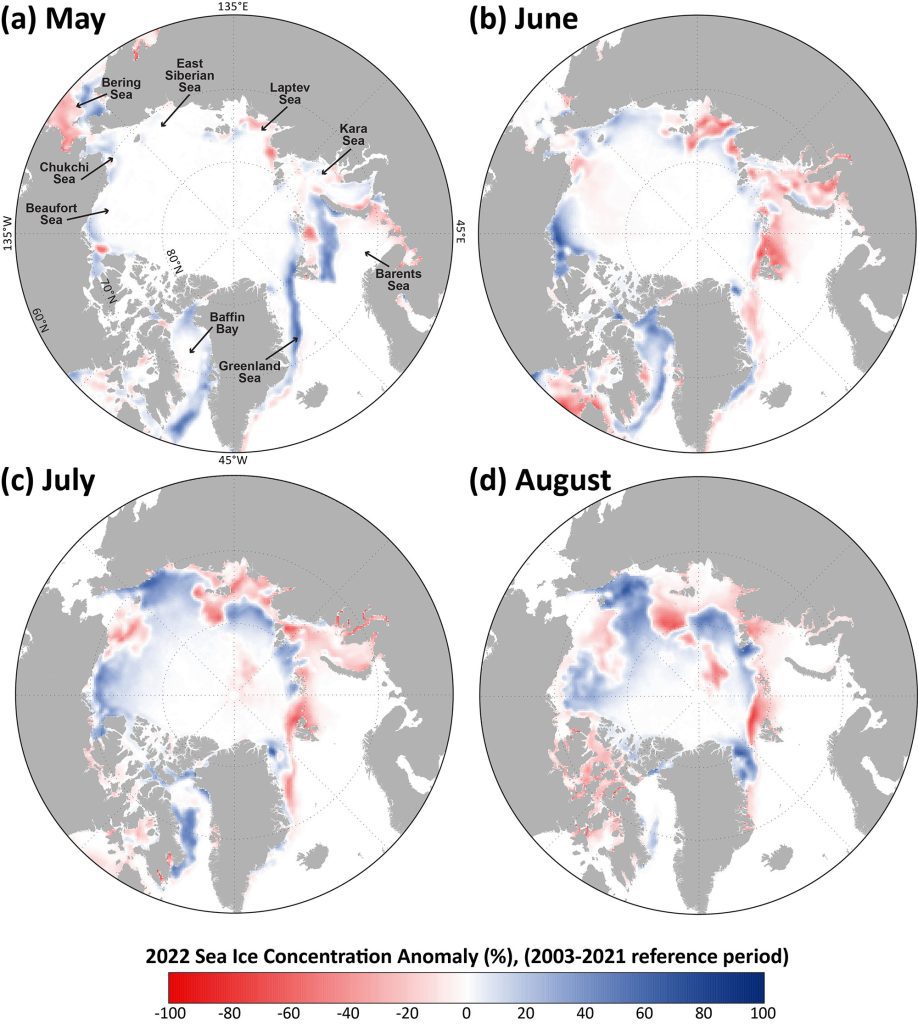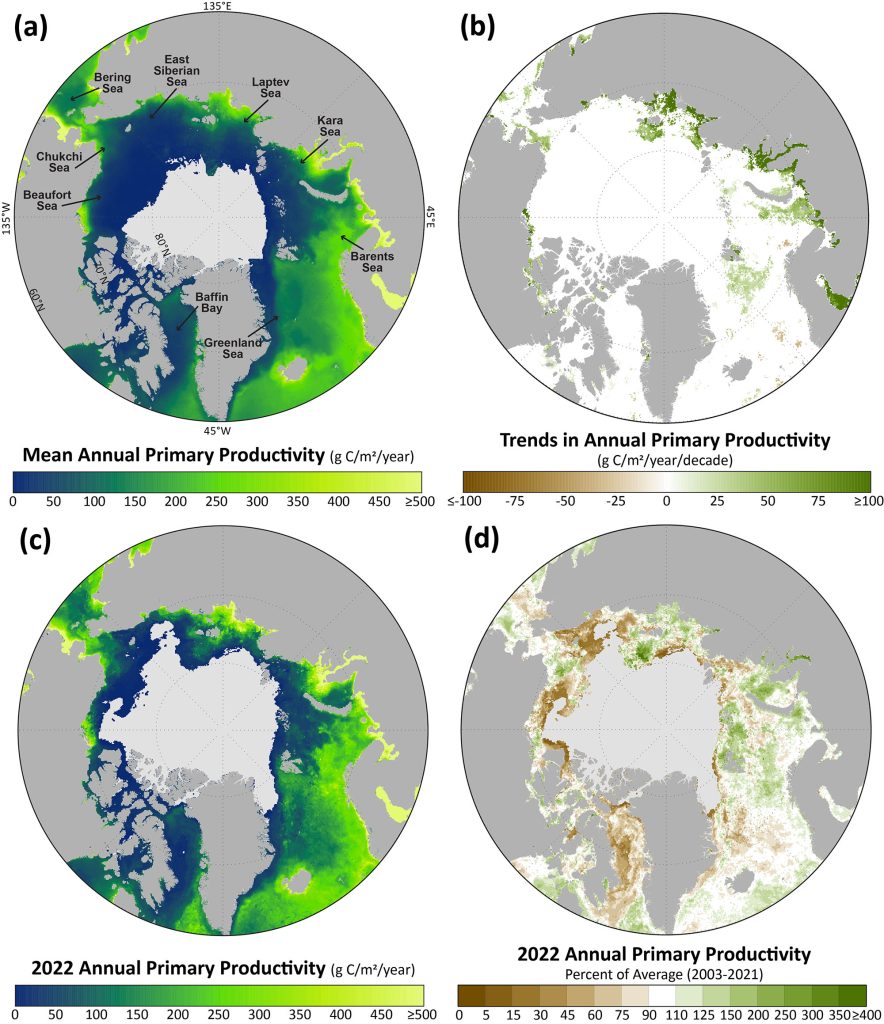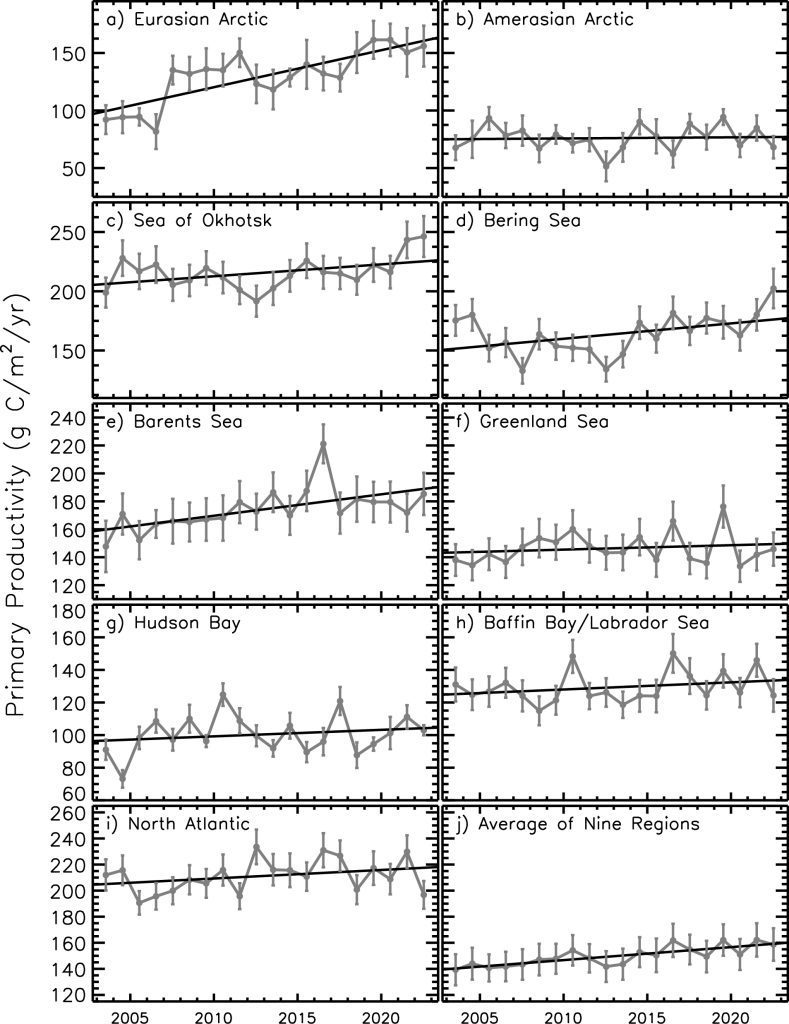K. E. Frey1, J. C. Comiso2, L. W. Cooper3, C. Garcia-Eidell4, J. M. Grebmeier3, and L. V. Stock2
1Graduate School of Geography, Clark University, Worcester, MA, USA
2Cryospheric Sciences Laboratory, Goddard Space Flight Center, NASA, Greenbelt, MD, USA
3Chesapeake Biological Laboratory, University of Maryland Center for Environmental Science, University of Maryland, Solomons, MD, USA
4Global Ocean Monitoring and Observing Program, NOAA, Silver Spring, MD, USA
Highlights
- Satellite estimates of ocean primary productivity (i.e., the rate at which marine algae transform dissolved inorganic carbon into organic material) showed higher values for 2022 (relative to the 2003-21 mean) for five of the nine regions investigated across the Arctic.
- All regions continue to exhibit positive trends in primary productivity over the 2003-22 period, with the strongest trends in the Eurasian Arctic and Barents Sea.
- Broad regions of lower-than-average primary productivity during 2022, particularly for the Beaufort Sea, East Siberian Sea, Greenland Sea, and Baffin Bay (associated with higher-than-average sea ice cover in these regions), contributed to the high variability of primary productivity over both space and time across the Arctic.
Introduction
Primary production by single-celled phytoplankton and sea ice algae forms the foundation of the Arctic Ocean’s unique ecosystems and the fisheries they support. Controlled by a complex interplay of light and nutrients, primary producers transform dissolved inorganic carbon into organic material. Light regimes and nutrient supplies in turn are both affected by seasonal melting and retreat of sea ice, water mass structure, and ocean circulation (Popova et al. 2010; Ardyna et al. 2017). Light availability is strongly influenced by the extreme seasonality (continuous sunlight in summer and darkness during winter), spring snow thickness on sea ice, as well as the number of open water days in areas with seasonal sea ice cover. In terms of nutrients, the open ocean regions of the Arctic are typically characterized by a well-stratified surface layer with low nutrient levels. Subsurface waters, however, are nutrient rich and the upwelling of these nutrients at the sea ice edge may support episodic phytoplankton blooms that account for half of the regional production within a season (Mundy et al. 2009). In addition to the upwelling of nutrients, high winds, glacial runoff, and efficient recycling of land-derived nutrients are also regionally important in helping to drive Arctic marine productivity (Crawford et al. 2020; Hopwood et al. 2020; Terhaar et al. 2021). Increasing ice-free conditions, nutrient availability, and warming across the Arctic can all result in increased primary productivity. At the same time, freshening caused by sea ice melt and increased riverine fresh-water input increases stratification, which restricts nutrient supply to surface layers (von Appen et al. 2021). Increased CO2 concentrations are also expected to have a fertilization effect on marine autotrophs, but this is highly temperature-dependent (Holding et al. 2015). These observations among others show that underlying drivers of marine primary productivity in a rapidly changing Arctic are not straightforward and depend on various processes, events, and features across different spatial and temporal scales. Satellite-based observations of ocean color are used to calculate marine chlorophyll concentrations that are then incorporated into more complex models that estimate ocean primary productivity, providing a synoptic view of the rates at which plant material is generated through photosynthesis across the Arctic Ocean. For further references, see Frey et al. (2021) and earlier Arctic Report Card essays.
Chlorophyll-a
We present satellite-based estimates of algal chlorophyll-a (occurring in all species of phytoplankton), based on ocean color, and subsequently provide calculated primary production estimates (below). The data presented in Fig. 1 show mean monthly ratios of chlorophyll-a concentrations for 2022 as percentages of the multiyear average from 2003 to 2021. Observed patterns, which are spatially and temporally heterogeneous across the Arctic Ocean, are often associated with the timing of the seasonal break-up and retreat of the sea ice cover (Fig. 2) (see essay Sea Ice): high percentages tend to occur in regions where the break-up is relatively early, while low percentages tend to occur in regions where the break-up is delayed. Some of the most notable patterns in 2022 are found in the western Barents and northern Norwegian Seas, with widespread higher-than-average concentrations of chlorophyll-a in May (Fig. 1a) and subsequent declines in June, July, and August (Figs. 1b-d). Higher-than-average chlorophyll-a concentrations are also notable in the central Barents Sea during June and July (Figs. 1b,c) and the northern Laptev Sea during July and August (Figs. 1c,d). In the Greenland Sea and Baffin Bay, broad areas of lower-than-average chlorophyll-a concentrations occur during all four months shown. A notable split of chlorophyll-a concentration departures from average exists in the Bering Sea, where lower-than-average values are found in the western Bering Sea and higher-than-average values are found in the eastern Bering Sea during all four months (Figs. 1a-d) and are consistent with patterns in sea ice cover observed during May (Fig. 2a).


Primary production
Chlorophyll-a concentrations give an estimate of the total standing stock of algal biomass. However, rates of primary production (i.e., the production of organic carbon via photosynthesis) provide a different perspective since not all algae present in the water column are necessarily actively producing. The mean annual primary productivity across the Arctic shows important spatial patterns, most notably the overall decreases moving northward as sea ice cover is present for a greater fraction of the year (Fig. 3a). Spatial trends in annual primary productivity (Fig. 3b) are a particularly useful tool for understanding hotspots of change. Those trends that are positive and largest are located in the Laptev Sea, reaching rates of ~100 g C/m2/yr/decade and higher (Fig. 3b). This is consistent with the Eurasian Arctic region as a whole, which exhibits the greatest increases in primary productivity compared to all other Arctic regions (Fig. 4, Table 1). Additional clustered statistically significant increasing trends in primary productivity appear in the eastern Bering Strait/eastern Chukchi Sea region, Barents Sea, and eastern Greenland Sea (Fig. 3b). Trends adjacent to the Eurasian coastline may be associated with variability in river-derived chromophoric (light absorbing) dissolved organic matter (CDOM) as well (e.g., Lewis and Arrigo 2020). Using this primary productivity product, nearly no evidence of significant decreasing trends in primary productivity across the Arctic exists (only isolated locations in the southern Barents Sea and Norwegian Sea; Fig. 3b). Investigations of 2022 annual primary productivity (Fig. 3c), as well as 2022 compared to the 2003-21 average (Fig. 3d), show greater-than-average annual productivity in the central Chukchi Sea, northern Laptev Sea, Kara Sea, and Barents Sea, but lower-than-average annual productivity in the Beaufort Sea, East Siberian Sea, Baffin Bay, and Greenland Sea. Many of these spatial patterns in productivity are reflective of 2022 sea ice conditions (Fig. 2; e.g., higher-than-average sea ice concentrations in the Beaufort Sea, East Siberian Sea, and Baffin Bay vs. lower-than-average sea ice concentrations in the northern Laptev Sea, Kara Sea, and northern Barents Sea).


| Region | 2003-22 Trend (g C/m2/yr/decade) |
2003-22 Mann-Kendall p-value |
2003-22 % Change |
2022 Anomaly (g C/m2/yr) from the 2003-21 reference period |
2022 Primary Productivity (% of the 2003-21 average) |
|---|---|---|---|---|---|
| Eurasian Arctic | 32.18 | 0.001 | 61.5 | 27.35 | 121.3 |
| Amerasian Arctic | 1.01 | 0.871 | 2.6 | -8.37 | 89.0 |
| Sea of Okhotsk | 10.09 | 0.127 | 9.3 | 32.11 | 115.0 |
| Bering Sea | 12.98 | 0.074 | 16.3 | 40.50 | 125.0 |
| Barents Sea | 15.34 | 0.000 | 18.2 | 11.56 | 106.7 |
| Greenland Sea | 3.17 | 0.626 | 4.2 | -0.66 | 99.6 |
| Hudson Bay | 4.02 | 0.581 | 7.9 | 2.64 | 102.6 |
| Baffin Bay/Labrador Sea | 4.41 | 0.496 | 6.7 | -5.23 | 96.0 |
| North Atlantic | 6.58 | 0.144 | 6.1 | -15.33 | 92.8 |
| Average of Nine Regions | 9.98 | 0.000 | 13.5 | 9.40 | 106.3 |
Estimates of ocean primary productivity in 2022 for nine regions and across the Northern Hemisphere (relative to the 2003-21 reference period) were assessed (Fig. 4, Table 1). The Eurasian Arctic designation includes the Kara Sea, Laptev Sea, and East Siberian Sea. The Amerasian Arctic designation includes the Chukchi Sea, Beaufort Sea, and Canadian Archipelago region. The North Atlantic region in this categorization is south of 60° N and east of 45° W, and as such is not inclusive of the Labrador or Greenland Seas. Our results show above-average primary productivity for 2022 in five of the nine regions investigated, while the Amerasian Arctic, Greenland Sea, Baffin Bay/Labrador Sea, and North Atlantic exhibit lower-than-average values (Fig. 4, Table 1). Across the whole time series, however, positive trends in primary productivity remain in all regions during the 2003-22 period. Statistically significant positive trends occurred in the Eurasian Arctic and Barents Sea, as well as on average for the nine regions. In particular, trends over the 2003-22 period have increased by ~61.5% in the Eurasian Arctic and ~18.2% in the Barents Sea. In summary, while observations of primary productivity show complex interannual and spatial patterns over the 2003-22 period, we continue to observe overall increasing trends across all sectors of the Arctic Ocean.
Methods and data
Measurements of the algal pigment chlorophyll (specifically, chlorophyll-a) serve as a proxy for the amount of algal biomass present in the ocean as well as overall plant health. The complete, updated Moderate Resolution Imaging Spectroradiometer (MODIS)-Aqua satellite record of chlorophyll-a concentrations within northern polar waters for the years 2003-22 serves as a time series against which individual years are compared. Satellite-based chlorophyll-a data across the pan-Arctic region were derived using the MODIS-Aqua Reprocessing 2022.0, chlor_a algorithm: https://oceancolor.gsfc.nasa.gov/. For this report, we show mean monthly chlorophyll-a concentrations calculated as a percentage of the 2003-21 average, which was chosen as the reference period to maximize the length of the satellite-based time series. Satellite-based sea ice concentrations were derived from the Special Sensor Microwave/Imager (SSM/I) and Special Sensor Microwave Imager/Sounder (SSMIS) passive microwave instruments, calculated using the Goddard Bootstrap (SB2) algorithm (Comiso et al. 2017). Monthly sea ice concentration anomalies were additionally calculated for 2022 (compared to the 2003-21 average) in order to streamline comparisons with the variability in monthly chlorophyll-a satellite data. Primary productivity data were derived using chlorophyll-a concentrations from MODIS-Aqua data (Reprocessing 2022.0, chlor_a algorithm), the NOAA 1/4° daily Optimum Interpolation Sea Surface Temperature dataset (or daily OISST) that uses satellite sea surface temperatures from AVHRR, incident solar irradiance, mixed layer depths, and additional parameters. Primary productivity values were calculated based on the techniques described by Behrenfeld and Falkowski (1997). Chlorophyll-a and primary productivity data only incorporate pixels where sea ice is less than 10%, which is a compromise between potential pixel contamination with sea ice and an attempt to incorporate open water near the ice edge that typically exhibits high rates of primary production. We define annual productivity as productivity over the March-September time period. The 2022 annual primary productivity percent of average (compared to 2003-21) was calculated the same way as for chlorophyll-a, as described above. Lastly, Theil-Sen median trends were calculated spatially (Fig. 3b) and for the extracted time series for each geographic region (Table 1), where statistical significance (p<0.05) of the trends was determined using the Mann-Kendall trend test.
It is important to note that the chlorophyll-a and primary productivity data are shown for ocean areas with less than 10% sea ice concentration and, therefore, do not include production by sea ice algae or under-ice phytoplankton blooms, which can be significant (e.g., Ardyna et al. 2020). Furthermore, it is well known that satellite observations can underestimate production under stratified conditions when a deep chlorophyll maximum is present (Bouman et al. 2020). The variable distribution of sediments and CDOM (owing to riverine delivery, coastal erosion, and sea ice dynamics) can also affect the accuracy of satellite-based estimations of chlorophyll-a and primary productivity in Arctic waters (Lewis and Arrigo 2020). As such, in-situ observations (e.g., Cooper and Grebmeier 2022; Gaffey et al. 2022) continue to importantly provide overall context for changes to and drivers of primary productivity across Arctic marine ecosystems. However, barriers to field-based measurements include the presence of Arctic storms (as was the case for multiple ships in the Pacific Arctic region in the summer of 2022; unpublished data), which also drive enhanced marine primary productivity through the vertical mixing of nutrients (Crawford et al. 2020).
Acknowledgments
K. Frey would like to acknowledge financial support by the National Science Foundation (NSF) Arctic Observing Network (AON) Program (Grant 1917434). Support for J. Grebmeier and L. Cooper was provided through NSF AON (Grant 1917469) and the NOAA Arctic Research Program (CINAR 22309.07_UMCES_Grebmeier). Support for C. Garcia-Eidell was provided by the Knauss Marine Policy Fellowship from the NOAA Sea Grant.
References
Ardyna, M., M. Babin, E. Devered, A. Forest, M. Gosselin, P. Raimbault, and J. -É. Tremblay, 2017: Shelf-basin gradients shape ecological phytoplankton niches and community composition in the coastal Arctic Ocean (Beaufort Sea). Limnol. Oceanogr., 62, 2113-2132, https://doi.org/10.1002/lno.10554.
Ardyna M., and Coauthors, 2020: Under-ice phytoplankton blooms: Shedding light on the “invisible” part of Arctic primary production. Front. Mar. Sci., 7, 608032, https://doi.org/10.3389/fmars.2020.608032.
Behrenfeld, M. J., and P. G. Falkowski, 1997: Photosynthetic rates derived from satellite-based chlorophyll concentration. Limnol. Oceanogr., 42(1), 1-20, https://doi.org/10.4319/lo.1997.42.1.0001.
Bouman, H. A., T. Jackson, S. Sathyendranath, and T. Platt, 2020: Vertical structure in chlorophyll profiles: influence on primary production in the Arctic Ocean. Philos. Trans. Roy. Soc. A, 378, 20190351, https://doi.org/10.1098/rsta.2019.0351.
Comiso, J. C., 2015: Variability and trends of the global sea ice covers and sea level: Effects on physicochemical parameters. Climate and Fresh Water Toxins, L. M. Botana, M. C. Lauzao, and N. Vilarino, Eds., De Gruyter, Berlin, Germany, https://doi.org/10.1515/9783110333596-003.
Comiso, J. C., W. N. Meier, and R. Gersten, 2017: Variability and trends in the Arctic Sea ice cover: Results from different techniques. J. Geophys. Res.-Oceans, 122, 6883-6900, https://doi.org/10.1002/2017JC012768.
Cooper L. W., and J. M. Grebmeier, 2022: A chlorophyll biomass time-series for the Distributed Biological Observatory in the context of seasonal sea ice declines in the Pacific Arctic region. Geosciences, 12(8), 307, https://doi.org/10.3390/geosciences12080307.
Crawford, A. D., K. M. Krumhardt, N. S. Lovenduski, G. L. Van Dijken, and K. R. Arrigo, 2020: Summer high-wind events and phytoplankton productivity in the Arctic Ocean. J. Geophys. Res.-Oceans, 125, e2020JC016565, https://doi.org/10.1029/2020jc016565.
Frey, K. E., J. C. Comiso, L. W. Cooper, J. M. Grebmeier, and L. V. Stock, 2021: Arctic ocean primary productivity: The response of marine algae to climate warming and sea ice decline. Arctic Report Card 2021, T. A. Moon, M. L. Druckenmiller, and R. L. Thoman, Eds., https://doi.org/10.25923/kxhb-dw16.
Gaffey, C. B., K. E. Frey, L. W. Cooper, and J. M. Grebmeier, 2022: Phytoplankton bloom stages estimated from chlorophyll pigment proportions suggest delayed summer production in low sea ice years in the northern Bering Sea. PLoS ONE, 17, e0267586, https://doi.org/10.1371/journal.pone.0267586.
Holding, J. M., and Coauthors, 2015: Temperature dependence of CO2-enhanced primary production in the European Arctic Ocean. Nat. Climate Change, 5, 1079-1082, https://doi.org/10.1038/nclimate2768.
Hopwood, M. J., and Coauthors, 2020: Review article: How does glacier discharge affect marine biogeochemistry and primary production in the Arctic? Cryosphere, 14, 1347-1383, https://doi.org/10.5194/tc-14-1347-2020.
Lewis, K. M., and K. R. Arrigo, 2020: Ocean color algorithms for estimating chlorophyll a, CDOM absorption, and particle backscattering in the Arctic Ocean. J. Geophys. Res.-Oceans, 125, e2019JC015706, https://doi.org/10.1029/2019JC015706.
Mundy, C. J., and Coauthors, 2009: Contribution of under-ice primary production to an ice edge upwelling phytoplankton bloom in the Canadian Beaufort Sea. Geophys. Res. Lett., 36, L17601, https://doi.org/10.1029/2009GL038837.
Popova, E. E., A. Yool, A. C. Coward, Y. K. Aksenov, S. G. Alderson, A. de Cuevas, and T. R. Anderson, 2010: Control of primary production in the Arctic by nutrients and light: insights from a high-resolution ocean general circulation model. Biogeosciences, 7, 3569-3591, https://doi.org/10.5194/bg-7-3569-2010.
Terhaar, J., R. Lauerwald, P. Regnier, N. Gruber, and L. Bopp, 2021: Around one third of current Arctic Ocean primary production sustained by rivers and coastal erosion. Nat. Comm., 12, 169, https://doi.org/10.1038/s41467-020-20470-z.
von Appen, W. J., and Coauthors, 2021: Sea-ice derived meltwater stratification slows the biological carbon pump: results from continuous observations. Nat. Comm., 12, 7309, https://doi.org/10.1038/s41467-021-26943-z.
November 22, 2022

